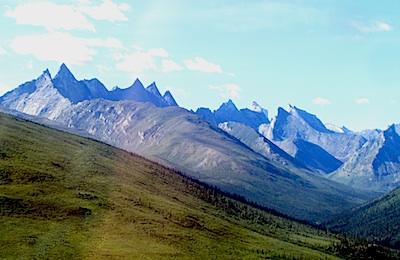
The Arrigetch Mountains of Gates of Arctic National Park and Preserve. Marlene Battelle photo.
Editor's note: Sometimes we just need to live vicariously through others. For many of us, that might be the case when it comes to visiting Gates of the Arctic National Park and Preserve. Marlene Battelle and her husband visited the park last summer and returned home with the following story, which first appeared on her blog, here2where and is reprinted here with her permission.
When you tell someone you are going to visit a national park north of the Arctic Circle, the first reaction is generally, 'That sounds very cold.' Contrary to that impression, north of the Arctic Circle in the summertime is not ice and snow at all and there can be 30 days of continuous sunlight. Tom and I visited Gates of the Arctic National Park in Alaska in late July and it was truly amazing. We had been planning this trip for over a year and we were certainly not disappointed.
Gates of the Arctic is not a particularly easy park to visit ' there are no roads and almost no facilities at all within the park. It definitely takes some planning and preparation. But it is SO worth it!
When it comes to national parks, in size Gates of the Arctic, at 7.5 million acres, is one of the big boys. In visitation it lies at the other end of the scale, with only 10,899 visitors in 2012. Gates is one of those parks you can visit and truly not see anyone except those in your own party.
There are several outfitters who offer trips into Gates that entail backpacking, canoeing, hiking, etc. There is one lodge located right on the edge of the park ' Iniakuk Lake Wilderness Lodge, owned and operated by mother and son, Pat and John Gaedeke. The Gaedekes also have two remote cabins within the park itself. Since we are now at a point in our lives where we prefer a bed to a tent with a sleeping bag on the ground, we chose an Iniakuk Lodge package that included two nights at the lodge itself and two nights at the remote Caribou Cabin. Pat and John were amazing hosts and it definitely was not 'roughing it.'
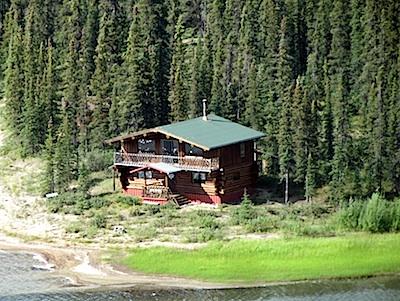
A guest cabin at the Iniakuk Lodge. Marlene Battelle photo.
We flew into Fairbanks, arriving early in the morning, which gave us a whole day before heading on further north. We visited the Museum of the North on the University of Alaska campus, went to Pioneer Park, and an exhibit of the TransAlaska pipeline. Since we had been traveling all night the night before, we were ready to call it an early night.
The real adventure began the next morning! We got up early to get breakfast at the hotel and get to Wright's Air Service for an 8 a.m. flight to Bettles. There we met our host John Gaedeke.
On this trip, the airplanes kept getting smaller and the destinations more remote. The plane for this portion of the trip was a 9-passenger Cessna Caravan. Also on board with us was a video crew heading out to film an Animal Planet River Rats segment. Talk about cameras ' theirs made mine look like a toy. They deplaned at Alakaket and we proceeded to Bettles, landing on the gravel strip.
Bettles has a summer population of about 38 people and a winter population of 10. However, this is where the National Park Service has a ranger station, so Tom and I immediately went there to talk to the ranger, and get my Park Passport book stamped.
The ranger gave us lots of information, and also officially dubbed us 'Guardians of the Gates' as we were on our way into Gates of the Arctic. Then it was time to go to the float pond to board the Brooks Range Air Service float plane (deHaviland Beaver) and fly to Iniakuk Lodge. It was our first time taking off and landing on water. It was awe-inspiring country to fly over ' so much water and incredible mountains!
After a smooth-as-glass landing on Iniakuk Lake, we were met by Pat and Eric, and our gear and other freight was unloaded. Tom and I had our own private cabin across Tobuk Creek from the lodge. John took us over by boat and was on call via radio at any time. Pat served gourmet meals at the lodge, with our lunch upon arrival being an example. We had salad greens (fresh from the onsite greenhouse), salmon, corn and mango salad, focaccia bread, and homemade cookies.
The weather was cloudy and threatening rain when we arrived but held off. John and Pat will accommodate any expertise and activity level. We're not fishermen and had had a couple of long days, so we spent part of our afternoon relaxing in the upstairs lounge in the cabin. It was was well-stocked with books and games and a great view of the ever-changing lake. We also hiked down to the lakeshore, where we saw moose tracks and a variety of wildflowers and berries.
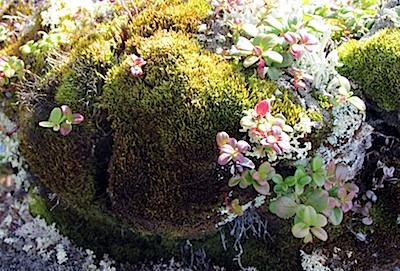
Tundra plants. Marlene Battelle photo.
For dinner, Pat served tri-tip roast, roasted potatoes, broccoli, salad, and apple crisp. It was all accompanied by interesting and enjoyable conversation. After dinner, John took us on the boat up the creek past two beaver lodges and down the opposite lakeshore and back, pointing out where they picked the cranberries for our dinner. The sun broke out of the clouds about midnight ' yes, midnight. When it never gets dark, it's really hard to have any sense of what time it actually is.
To my way of thinking, fresh hot coffee appearing on your doorstep in the morning absolutely starts the day off right. And at 6:30 there it was! Of course, it was followed later by a terrific breakfast. We then packed lunches and set out for a hike up toward Mount Hal Waugh. We followed a game trail from the end of the beach to the Rocky Knoll overlook and then on up further.
It was steep going and somehow caribou, moose, and bears don't see the need to make switchbacks. We didn't see any major wildlife but did see tracks and scat. John was a veritable encyclopedia of knowledge pointing out blueberries, bearberries, wild currants, monk's hood, and caribou moss and answering innumerable questions. We had great views of the lake and surrounding mountains. Knowing you are very remote but having a guide who is completely at home in, and a part of, the surroundings makes for an amazing experience. After dinner, a boat ride around the lake completed the day.
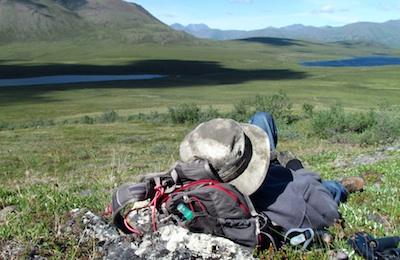
A great vista for a nap. Marlene Battelle photo.
Approximately 10 a.m. the next morning, Dan flew in and landed on Iniakuk Lake, bringing in supplies and picking John, Tom, and me up for the flight to the Caribou Cabin at the headwaters of the Alatna River, 100-plus miles north of the Arctic Circle. I was totally impressed with the speed with which we took off of the lake and the trip was one I spent glued to the window trying to take it all in. The mountains in the Brooks Range are incredible, and the Arrigetch Peaks are some of the most rugged in the United States.
The rivers twist and turn and you could use the photos from the plane for a science lesson with oxbow lakes, goosenecks, and all kinds of formations laid out below. The only methods of travel in this part of the world are on foot, by boat, or by plane. We basically followed the Alatna River all the way to the headwaters, flying between and around mountains. Exhilarating!
The Caribou Cabin is on the shore of the lake which is the headwater of the Alatna River and it is on a caribou migration route. Unfortunately we were there too early for the migration so the only caribou we saw were from the plane on our way back out. Even so, it is totally fascinating. The scope of everything is impossible to describe. When you get reflections in the lake of mountains that are twenty-five miles away, you know it is just plain BIG country.
The facilities here were more 'rustic' ' translate that to mean an outhouse ' but it was still a far cry from roughing it. We had lights in our cabin, a woodstove for heat and John cooked great meals which Pat had sent along. The porch overlooked the lake and the chewed-on posts were a testament to the fact that yes, this is bear country. There was a bear trail right behind the cabin. We didn't see any but where the caribou come so do the wolves and bears.
When we flew in, it was cloudy, cold and trying to rain but a couple of hours later the sun came out and we had perfect weather the whole time we were there. A real plus was that the mosquitoes were not bad! After lunch we hiked up behind the cabin to a rocky knoll and sat and watched for movement. Much of viewing wildlife involves being very patient. Sometimes a nap is even called for.
The only things we saw were birds. The vastness could be overwhelming but somehow was not. Here we were in Gates of the Arctic ' three people and umpteen million acres of wilderness ' nearly insignificant but a part of something enormous and important. So we hiked back, enjoyed cocktail hour on the porch and had another great dinner.
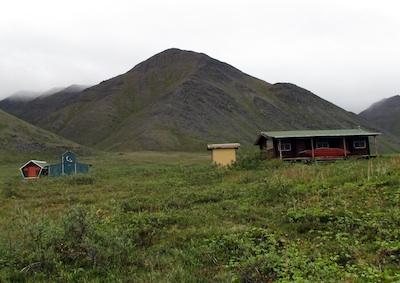
"Rustic" is a good word to describe the Caribou cabin, but it's better than sleeping on the ground. Marlene Battelle photo.
The next morning, after breakfast and packing our lunches, we set out for a hike toward the divide. On the other side of the divide the Killik River flows to the north to the Arctic Ocean, while on this side the Alatna flows south toward the Koyukuk and to the Yukon and then west to the Bering Sea.
Tundra is deceiving. It looks like it would be easy hiking since it appears to be relatively flat. However, the tundra is marshy with willows making passage difficult. Tussocks, which are clumps of grasses, tend to roll when you step on them so it is easy to twist an ankle. They are also so uneven that it is difficult staying between them. At any rate, the hiking is a lot harder and more strenuous than one would expect. At one place where we stopped for a breather, there was an area which had been dug out and John explained that it was one of the places where the Crislers had built a cabin during their stay in the Brooks Range studying wolves for a documentary for Disney. Lois Crisler's book was one of several we had read in preparation for our trip. We spent time watching for wildlife but saw only birds and wildflowers. It was a beautiful day!!
Since every plan in Alaska is predicated on 'weather permitting' we almost had mixed feelings the next morning when it was beautiful so Dan could come back and pick us up. Staying longer would certainly not have been a bad thing. The Beaver appeared over the river at about 10:30 and set down on the lake. We packed in all the gear and Dan had spotted caribou on his way in so he circled around so we could see them and get a glimpse of the Killik. We also saw moose on the way out and had great views of the Arrigetch Peaks. We landed on Iniakuk Lake, left John off there and bid farewell to Pat, then were off to return to Bettles. After a couple of hours in Bettles, we once again boarded a Cessna Caravan for the flight back to Fairbanks via Alakaket and Holmes.
If You Go:
Iniakuk Lake Wilderness Lodge
Toll Free: (877) 479-6354 | Phone: (907) 479-6354
Skype: iniakuklodge | Email: [email protected]Package prices: $3625-$12,755



Comments
And I thought the other Alaska parks were challenging/expensive to get to! Sounds like this was worth the effort. Thanks for sharing your adventure with us.
Thanks for such a great article! I visited Alaska for the first time last year and am returning again this August. Looks like I'll have to put this place on my "must-visit" list.
Excellent article. I spent many years exploring the central Brooks Range, both before and after it was included in the Gates of the Arctic Nat. Park & Preserve. It is truly a magic place filled with hidden secrets and pleasures waiting to be discovered.